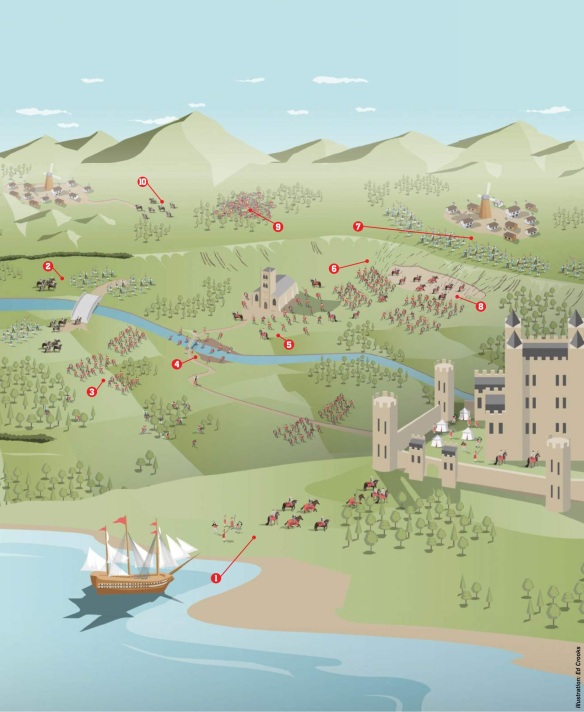1. FAILED RECONNAISSANCE The English army marches inland from the coast, conquering Maine and settling in the castle of Beaufort. French scouts track the English advance but are captured and interrogated. Now Clarence knows for sure that a rival army is close by.
2. FRENCH AND SCOTTISH MOVEMENTS The Franco-Scot forces march west from Tours and cut off the English escape route north that leads to the safety of Normandy. The two armies are now only 12.9 kilometres (eight miles) apart.
3. CLARENCE’S HURRIED MARCH Eager to engage the French, Clarence and 1,500 men-at-arms dash towards the French camp after sightings are confirmed by the English forward foraging parties. As second in command, the Earl of Salisbury Thomas Montgau is told to assemble archers and then follow his superior into battle.
4. CROSSING THE RIVER The French and Scottish forces congregate on the other side of the river Couesnon. The only bridge is heavily garrisoned, so the English knights dismount and wade across the river in full armour. Outflanked, the French and Scots retreat into a church.
5. ATTACK ON THE CHURCH Bursting out from the river bank, the English men-at-arms assault the church. The river crossing leaves the English troops scattered and disorganised and very few troops are now under effective command, as many are still on the road behind.
6. CLARENCE PRESSES ON A lull in the fighting gives Clarence the opportunity to wait for reinforcements. Foolishly, he declines and advances towards the village of Baugé. Hidden over the ridge lies the main force of Franco-Scots, who vastly outnumber the English.
7. THE FINAL CHARGE The Scottish and French forces are now back in line, but once again ignoring the advice of his commanders, Clarence presses on. A charge up the hill to the waiting Franco-Scots is ordered despite Salisbury and the archers still not arriving.
8. MELEE AND ENGLISH DEFEAT After a desperate assault, the English are routed by the larger French and Scottish army as Clarence and all of his commanders are killed. Without the support of the longbowmen, the English lose more than a thousand men, while the French and Scottish casualties only number in the hundreds.
9. SALISBURY’S LATE ARRIVAL The French and Scottish leave the battlefield, along with the mountain of English bodies behind to rot. Salisbury arrives the next day with reinforcements but he is too late to even glimpse the opposing army, and to his horror, finds only the dead.
10. MOMENTUM WITH THE FRENCH Clarence’s body is recovered and shipped back to England, where an angered Henry V prepares to return to France with a new army. After the battle, and with the confidence of their victory, the French begin planning a conquest of Normandy.
The English aura of invincibility was finally lost as a reckless advance saw their forces obliterated by a French and Scottish coalition Nearly six years had passed since Agincourt and Henry V was still the master of northern France. The dauphin, the future Charles VII, desperately appealed to the Scots for help, and soldiers arrived shortly after, ready for battle against the English. By March 1421, Henry was back in England, so the heir to the throne, Thomas of Clarence, led the army in his stead. Utilising chevauchée raiding tactics, Clarence swept inland, plundering his way through the countryside. Meeting little to no resistance, it wasn’t until the end of the month that the French would finally muster a force to fight back.
The Battle of Baugé was the zenith of Scottish support in France in the Hundred Years’ War. The Scots had been at war on and off with the English for decades and had actively assisted the French since 1382, when they were asked to join with Charles VI in return for equipment and supplies. The French had supported Scotland during Edward I’s invasion of the country, so both had a history of common interest. The agreement was known as the `Auld Alliance’ and was a constant thorn in the side of the English, as the French and Scots tried to force a war on two fronts. The Truce of Leulinghem was signed with the English in 1389, but it wasn’t long until the Scots were back in the fold. After Baugé, the Scots were involved in the losses at the battles of Cravant and Herrings and their role in the war was effectively at an end after a major defeat at the battle of Verneuil. Taking place 80 kilometres (50 miles) west of Paris, the Franco-Scots’ charge was decimated by the English longbowmen, who killed half of the opposing forces.
